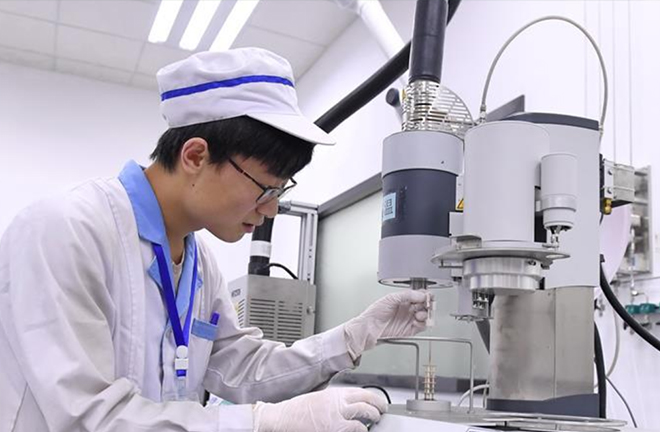Independent innovation key to domestic circulation

An engineer runs a test for CATL, one of world’s most valuable electric battery suppliers based in Fujian Province. Photo: XINHUA
Economic circulation starts in production and ends with consumption. The domestic market’s priority is to improve the supply system’s adaptability to domestic demand, thus forming a better dynamic balance in which demand leads supply while supply creates demand. In these aspects, technological innovation should have a major role.
The development paths of many countries are the testament that an economic growth pattern driven by innovation is the key prerequisite for a continuous increase in labor productivity. Within time, this growth pattern can be achieved through the introduction of technology. However, the introduction of technology is a complex process of innovation, rather than the imitation of existing technologies and products. At the same time, we can’t count on this method to support long-term high-quality growth. As a major developing country, it is not feasible for China to maintain long-term stable economic growth and increase citizens’ income through the introduction of technology alone. At present, a new round of technological revolution is already booming. Global competition in technology and innovation is getting fiercer. China is tasked with strengthening independent innovation, thus catalyzing high-quality economic growth.
In the 13th Five-Year Plan period, China’s tremendous effort in developing innovation ability bore fruit. In the 14th Five-Year Plan period, reforms and innovations should focus on incentive mechanisms, economic factor circulation mechanisms, and collaborative mechanisms for upgrading the innovation and the industrial chains.
First, China should optimize its distribution mechanisms to highlight the value of knowledge, providing incentives for innovation. This form of mechanism is necessary in the promotion of scientific and technological innovation. The factor-intensive economy needs to transform itself into an innovation-driven economy, as the advantages of low-cost factors are dwindling. The establishment of such a mechanism will drive China to be more innovative, thus tackling the challenges brought by the reducing rewards of follower-style innovation.
Furthermore, China should consolidate its multi-level innovation system and smooth the circulation of innovation factors at all levels. National demonstration zones for independent innovation should be encouraged to deepen the institutional innovation of the regional innovation system and to explore new models of regional collaborative innovation development so that the innovation systems at all levels and regions can complement each other. Thus, an open, comprehensive, multi-level and multi-agent pattern dedicated to collaborative innovation will take shape. A unitary supply market targeting innovative factors is needed to remove various barriers among regions and sectors and gradually break down the institutional hurdles that impede the flow of innovation factors such as talent, technology and capital. The country needs to emphasize the role of digital resources as an innovation factor, build a data protection system and establish unified data usage regulations, thereby facilitating the free circulation of data.
Finally, the country needs to optimize a system that supports the coordinated upgrading of the industrial and innovation chains, thus leveraging independent innovation in the circulation of the domestic economy. China should foster endogenous power for independent innovation. Moreover, cutting-edge science fields should embrace more strategic deployment while national-level innovation platforms should command greater autonomy, thus enhancing their ability to commercialize research outcomes. China will aim to form a system that integrates technology, education, sectors and finance while encouraging universities and research institutes to cooperate with enterprises. In this way, the country can establish a comprehensive innovation chain covering basic research, technological development, supporting policies, demonstration zones and commercialization.
This article was edited and translated from Guangming Daily. Zhang Qizi is deputy director of the Institute of Industry and Economics at the Chinese Academy of Social Sciences.
edited by MA YUHONG

 PRINT
PRINT CLOSE
CLOSE